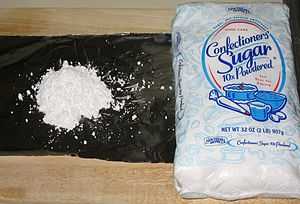Powdered sugar

Powdered sugar, also known as confectioners' sugar or icing sugar, is very fine sugar. When intended for home use, it typically contains a small amount of anti-caking agent.
In industrial food production, it is used where a quick dissolving sugar is required. Domestically, it is principally used to make icing or frosting and other cake decorations. It is often lightly dusted onto baked goods to add a light sweetness and subtle decoration.
Powdered sugar is available in different degrees of fineness , most commonly XXX, XXXX, and 10X, with more Xs indicating finer grains.[1] Powdered sugar is generally mixed with cornstarch, wheat flour, or calcium phosphate to improve its flowing ability, and thus it is not generally used to sweeten beverages. Industrial grades without these additives are available. However, icing sugar in the UK does not have cornstarch or wheat flour added.
One can make powdered sugar at home by putting normal granulated sugar in a coffee grinder or grinding it by hand in a mortar and pestle.
Caster sugar (also referred to as superfine or baker's sugar) has a larger particle size, up to approximately half that of granulated sugar.
Snow powder (or snow sugar) is a non-melting form of icing sugar usually consisting of dextrose, starch and anti-binding agents, useful for retaining its structure when dusted onto cakes or pastries that require refrigeration. It is mostly used for decorative purposes.
References
- ↑ "The Crushing Difference Between Granulated & Confectioners' Sugar". O Chef. Retrieved 2008-01-16.